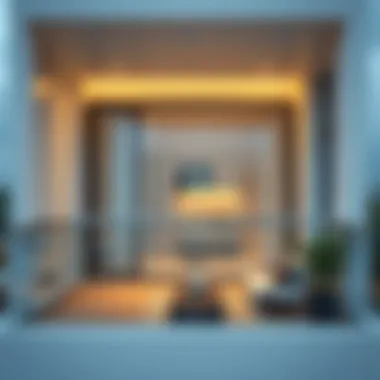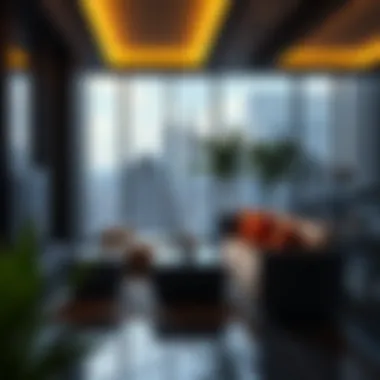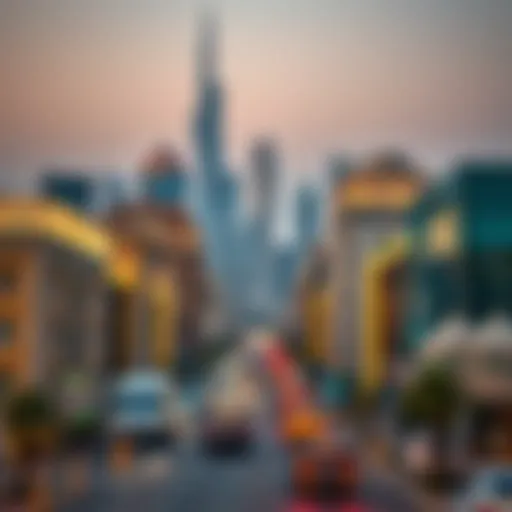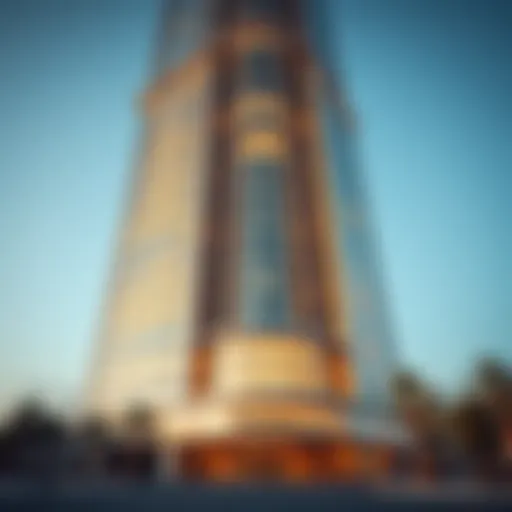Exploring Modern Balconies: Design and Trends


Intro
In recent years, modern balconies have evolved from mere extensions of buildings into vital components that enhance both the aesthetic and functionality of residential and commercial spaces. Today, they're not just places for enjoying morning coffee or evening breezes; they're integral to the overall architectural narrative of a structure. With their designs branching out into various styles and materials, modern balconies provide a fresh perspective on outdoor living. As we dive into this exploration, we’ll discuss how these outdoor spaces contribute to property value, appeal, and the broader landscape of architecture.
This article will cover the latest market trends that shape the design and functionality of modern balconies, offering insights into how they reflect and influence contemporary tastes. We'll also delve into investment opportunities and elucidate key areas that promise high returns in balcony enhancements. Armed with this knowledge, homeowners, architects, and real estate professionals can navigate the rapidly changing marketplace with confidence.
Understanding Modern Balcony Design
The design of modern balconies plays a crucial role in the overall aesthetic and functionality of contemporary architecture. Balconies have evolved from simple platforms to complex, multi-functional spaces that enhance the living experience. Their importance extends beyond just looks; they significantly impact the quality of life for residents and can even affect property values in an increasingly competitive housing market.
In essence, understanding modern balcony design involves a consideration of not only the visual appeal but also the functionality, sustainability, and integration with the surrounding environment. An effective balcony design can provide outdoor enjoyment, increase natural light, and improve airflow in homes.
Historical Context
To appreciate the modern elements of balcony design, one must recognize the historical evolution of balconies. In ancient civilizations, balconies served as vantage points for both functionality and style—think of the rustic wooden balconies in medieval Europe or the grand stone terraces in the Mediterranean villas. These structures have long been associated with wealth and social status, greatly influencing architectural styles.
Over time, preferences shifted. The Industrial Revolution catalyzed new materials like wrought iron and glass, which broadened the scope and function of balconies. These changes led to the incorporation of balconies in different architectural movements, from Gothic revival to Modernism in the 20th century. Today, balconies are not just an architectural whimsy or a decorative feature, but crucial elements that speak to sustainability and urban living. In a fast-paced world, they provide a necessary escape into nature without sacrificing the comforts of home.
Modern Aesthetic Principles
Modern aesthetics in balcony design adhere to principles rooted in simplicity, functionality, and harmony. A key focus has been on creating spaces that feel open and inviting, employing sleek lines and minimalist designs that avoid visual clutter. Materials like glass and steel are often favored for their transparency and strength, allowing for a seamless integration with the surrounding environment.
Balconies are now designed to extend the indoor experience outdoors, promoting a sense of continuity. Features like integrated seating, planters, and ambient lighting are common to create a soothing retreat. The color palettes lean towards neutral tones, allowing the natural elements to shine. Furthermore, with the trend revolving around biophilic design, many modern balconies incorporate greenery into their architecture, harmonizing urban spaces with nature. This not only enhances aesthetics but also contributes to better air quality and mental well-being.
"A balcony is not merely an extension of a house; it’s a personal oasis in the sky."
Key Features of Modern Balconies
The modern balcony is much more than a simple extension of a living space; it serves as a bridge between indoor comfort and outdoor enjoyment. As we look into the key features that define contemporary balconies, we identify elements that enhance aesthetics, practicality, and even value. Today’s designers prioritize not only the visual appeal but also the materials used and the innovative elements incorporated into the designs. These features reflect changing lifestyles and our demand for more versatile living areas.
Material Selection
The selection of materials plays a crucial role in defining the structure and functionality of modern balconies. With various options available, choice can tilt towards durability, beauty, or ecological impact.
Concrete
Concrete stands strong as a backbone for many modern balconies, not just in urban settings but also in suburban homes. Its key characteristic is the ability to hold weight and withstand harsh weather. An advantage of concrete is its longevity and low maintenance requirements, appealing to homeowners who favor practicality.
However, one must consider its aesthetics; while concrete can be stylish with the right finishes, it often requires additional treatments to soften its look. Unique features of concrete balcony designs may include textured surfaces or integrated planters, making them stand out.
Glass
Glass balconies are all the rage currently, as they offer a beneficial way of enhancing views without obstruction. Its key characteristic is transparency, which allows natural light to flood spaces. This feature not only improves the ambiance but also creates a sense of openness.
However, glass requires careful upkeep; fingerprints and smudges can be a pain. When considering safety, tempered or laminated glass is essential since it avoids breakage hazards. Given its aesthetic appeal, glass continues to be in demand despite its cleaning challenges.
Metal
Metal balconies, particularly those made from steel or aluminum, infuse a modern, industrial flair into designs. Their key characteristic is strength coupled with versatility. Steel, for instance, can support larger spans without needing much vertical support, making it popular for building designs where open spaces are desired.
The downside can be corrosion over time; thus, protective coatings are vital. Unique features may include custom railings or artistic designs, and when painted or treated appropriately, metal can also blend seamlessly with natural surroundings.
Wood
Wood brings warmth to the often-utilitarian balcony design, providing a cozy aesthetic that many homeowners covet. The key characteristic of wood is its organic charm and comfort underfoot. Furthermore, wood is advantageous because it can be easily manipulated into unique shapes and designs, offering limitless possibilities for creative balconies. However, it does require more regular upkeep than other materials, including staining or sealing to protect against weathering. Also, considering sustainable sources is crucial here, as many are pushing towards eco-friendly solutions when selecting wood.
Innovative Design Elements
Modern balconies incorporate innovative design elements that not only catch the eye but serve functional purposes as well. These elements amplify the balcony's usability and appeal, ensuring they remain a desirable feature in any property.
Overhang and Projection
Overhangs and projections extend the balcony space, creating a shaded area that can be used rain or shine. This key characteristic maximizes outdoor enjoyment throughout the year, providing respite from the sun and protection from light rains.
The advantages of such features include more usability in various weather conditions. However, proper design is crucial; excessive overhangs might create structural stress that needs addressing in the building process.
Balustrade Variations


The balcony balustrade can serve as both a safety feature and a design focal point. Key variations in materials and styles, such as glass panels, metal railings, or even natural wood, allow homeowners to express their style preference while maintaining safety.
Balustrades can enhance the overall design such that they can seem like art pieces themselves. However, they must be designed with caution to meet safety regulations, making it essential to choose reliable contractors and materials.
Integrated Landscaping
Integrating landscaping into balcony designs blurs the line between outdoor and indoor living. This feature involves incorporating planters, living walls, or even small trees. The key characteristic here is the way it humanizes the balcony space, making it a mini-ecosystem. The advantages include creating a relaxing retreat in an often-bustling urban environment. However, structural adjustments may be necessary to accommodate soil, drainage, and water supply, which could increase initial renovation costs.
Understanding these key features allows both homeowners and developers to maximize the benefits modern balconies offer. With careful consideration, these spaces can enhance individual lifestyles and elevate property values.
Functional Aspects of Modern Balconies
Understanding the functional aspects of modern balconies is essential for grasping their true value in contemporary spaces. These areas are not just architectural add-ons; they play significant roles in enhancing the livability and usability of homes and commercial properties. A balcony, at its core, is an extension of the indoor space, allowing individuals to engage with the outdoors in a curated environment.
From outdoor lounging to urban gardening, modern balconies are evolving into multifunctional spaces that meet diverse needs. They offer an opportunity to blend interior and exterior living, creating seamless transitions that enhance experiences of light, air, and nature.
Utilization of Space
Outdoor Living Areas
Outdoor living areas on balconies emphasize the concept of extending one’s home into the open air. Imagine sipping coffee while soaking in the morning sun or hosting intimate gatherings against the backdrop of a sunset. This aspect transforms balconies from mere appendages into vibrant living spaces.
A primary characteristic of these areas is their versatility. Furniture selection becomes pivotal; from weather-resistant loungers to compact dining sets, modern designs cater to any style while respecting limited space. The significant benefit of this variety is that homeowners can maximize relaxation and social interaction right at their doorstep.
However, one consideration is furniture durability. Heavy gusts of wind can upend lightweight items, and not all materials resist moisture equally well, which is an aspect to keep in mind when planning.
Gardening and Greening
Gardening on balconies has surged in popularity, representing a move towards sustainable living and eco-friendliness. As city dwellers seem to crave a connection to greenery, balconies serve as the perfect spot for creating mini-urban jungles.
One of the key characteristics of this aspect is the variety of plants that can thrive in restricted spaces. Flower boxes, vertical gardens, and container plants offer solutions for those eager to embrace nature from home. Such features not only decorate the space but also contribute to improving air quality, making balconies genuinely holistic living environments.
However, maintenance cannot be overlooked. Plants require constant attention and can pose challenges such as potential pest issues or water management leaks when not tended to properly.
Recreational Spaces
Recreational spaces on balconies cater to the leisure and well-being of occupants. These areas can include a tiny home gym, meditation nook, or even a shaded reading corner. The idea is to create a retreat where individuals can unwind and nurture their mental health.
The uniqueness of such spaces stems from their ability to offer personalized retreats without leaving home. One can easily dedicate a corner to yoga mats or set up a small bar for evening cocktails with friends. The integration of aesthetics with functionality makes recreational spaces a highly appealing aspect of balcony design.
On the flip side, space constraints pose a challenge. How to balance relaxation with functionality can become a meticulous puzzle when every inch counts.
Balconies and Natural Light
Natural light plays a vital role in enhancing the appeal of any living space, and balconies serve as an essential conduit for this bright element. Large glass doors or carefully arranged railing designs can flood these spaces with sunlight, creating warm and inviting atmospheres. Moreover, the sunlight streaming across a well-furnished balcony elevates not only mood but also the overall aesthetic of the property.
Through smart design choices, the effectiveness of natural light can be maximized. Light-colored furniture can reflect rather than absorb heat, while awning or shade solutions can intelligently manage exposure based on the time of day. The relationship between balconies and natural light, thus, is not merely functional but deeply ingrained in improving the quality of life in urban environments.
Environmental Considerations
In the age of climate awareness, the environmental considerations that affect modern balcony designs can not be overlooked. Balconies aren’t just aesthetic enhancements, they play a pivotal role in promoting sustainability in urban landscapes. Homeowners and real estate investors alike are increasingly interested in how these outdoor extensions can be designed to reduce ecological footprints. It's about marrying aesthetics with functional sustainability—capturing the essence of modern living while nurturing the planet.
Sustainability in Design
Energy-Efficient Features
One of the most valuable aspects of modern balcony design is the integration of energy-efficient features. Balconies can be equipped with various systems that actively reduce energy consumption. For instance, integrating solar panels into the balcony design enables homeowners to harness renewable energy sources. This not only decreases reliance on traditional energy grids but also cuts down on utility bills, a win-win for both the environment and household finances.
Another key characteristic of energy-efficient balconies is their orientation. Proper placement can maximize natural sunlight, reducing the need for artificial lighting. A balcony with a southward orientation will benefit from extended daylight hours, enhancing the space's usability throughout the day.
Despite the advantages, there are considerations. The upfront costs for these energy-efficient upgrades can be substantial. However, when viewed through the lens of long-term savings and environmental impact, many find it a worthy investment. A unique feature that often comes into play are advanced glazing systems used on glass railings, which can aid in thermal insulation—keeping spaces cooler in summer and warmer during winter months.
Use of Recycled Materials


Another facet of sustainability is the use of recycled materials in balcony construction. This aspect brings a dual advantage: reducing the demand for new raw materials while diverting waste from landfills. For instance, balconies constructed from recycled aluminum or reclaimed wood not only offer aesthetic appeal but also showcase a commitment to environmental stewardship.
The key characteristic of using recycled materials is their versatility. They can be shaped, molded, or treated to fit a variety of styles, from rustic to modern minimalism. Balconies made from these materials come with the benefit of being lighter and often more durable due to their processing, which in turn can reduce structural stress on buildings.
That said, concerns about sourcing and quality control remain. However, many manufacturers are now dedicated to ensuring high standards in recycled products, making it easier for builders and homeowners to make responsible choices. Additionally, an eye-catching balcony that features such materials can enhance property appeal, aligning with eco-friendly trends that many homebuyers prefer today.
Climate Adaptability
Adaptability to local climate conditions is another important element of balcony design. Climate adaptability ensures that balconies perform well across different weather conditions while minimizing energy use and maintaining comfort in outdoor living spaces. For example, balconies designed to effortlessly handle heavy rainfall feature sloped surfaces to prevent water pooling, while those in sunny regions might incorporate shading elements to cool down the space.
Effective climate responsiveness can significantly enhance the usability of a balcony throughout the year. Implementing features like retractable awnings or bioclimatic pergolas can adjust to sun exposure, offering shade when needed or allowing sunlight during cooler months. Such flexibility not only improves outdoor comfort but also increases the balcony's value as an integral part of the home.
Modern balconies that take into account environmental considerations effectively align with market trends and consumer preferences. They encourage the creation of more livable spaces that are in harmony with nature, turning balconies into sustainable sanctuaries that cater to both aesthetics and environmental mindfulness.
"A balcony is more than an architectural feature; it’s an opportunity for sustainable living in an urban environment."
For more information about sustainable architecture and practices, consider checking resources such as Wikipedia or Britannica.
Trends Impacting Modern Balconies
The landscape of balcony design is not static; it evolves with the currents of technology, cultural shifts, and lifestyle changes. Understanding the trends impacting modern balconies is crucial for investors, homeowners, and architecture professionals alike. These trends not only serve aesthetic purposes but also add functionality to outdoor spaces, ensuring they remain relevant and appealing in an ever-changing market.
Smart Technology
In the age of digital convenience, smart technology has woven itself deeply into our daily lives, extending its reach into the realm of balcony enhancements. The advent of smart tech in balcony design introduces a level of comfort and usability that was previously unattainable.
Remote Controls
Remote controls represent a critical component of this technological wave. These devices allow homeowners to manage features like awnings, blinds, and outdoor heating with the mere touch of a button. The key characteristic here is accessibility; instead of trudging outside to adjust settings, users can do so from the comfort of their living rooms.
The uniqueness of remote controls lies in their versatility. They can control multiple elements, enhancing the overall experience of balcony use. Advantages include increased comfort and a seamless transition between indoor and outdoor environments, while a potential disadvantage could be reliance on batteries or power sources, which could lead to inconvenience during outages.
Integrated Lighting Systems
Another significant trend is the implementation of integrated lighting systems on balconies. These systems can be adjusted with ease to create the desired atmosphere, whether it's a cozy dinner setting or a vibrant gathering space. A major advantage of integrated lighting is the aesthetic enhancement it brings; strategically placed lights not only illuminate but also accentuate architectural features of the balcony.
Its unique feature is the ability to customize brightness and color temperature through smart devices, which gives users a degree of control that old-fashioned lighting simply can't offer. While the consideration of price may come into play, the long-term benefits often outweigh the initial investments, making it a sound choice for modern balcony designs.
Minimalism in Balcony Design
Minimalism as a design philosophy has influenced various facets of architecture, and balconies are no exception. This trend embraces simplicity and functionality, stripping away unnecessary details while promoting clean lines and open spaces. The hallmark of minimalist balcony design is its focus on maximizing utility while minimizing visual clutter.
In this context, furniture selection becomes pivotal. Opting for foldable or retractable pieces can greatly enhance the usable space while maintaining an air of sophistication. With fewer decorative items, the balcony can act as a serene retreat rather than an overcrowded area. This restraint instills a calmness synonymous with modern living.
In summary, the trends of smart technology and minimalism in balcony design are paving the way for more functional, appealing outdoor spaces. These elements not only cater to contemporary aesthetics but also respond to the practical needs of a discerning audience, thereby enhancing the overall value of properties.
Balconies and Real Estate Value
Balconies play a significant role in influencing the value of real estate. When it comes to buying or selling a property, many potential buyers see balconies as attractive features that enhance the overall living experience. They provide outdoor space which can serve a multitude of purposes, from intimate cafes to family gathering spots. This section will discuss the market trends regarding balconies, the impact they have on property prices, and the preferences of today's home buyers.
Market Trends
Impact on Property Prices
The inclusion of a balcony can have a noticeable effect on property prices. In urban areas, where space is at a premium, buyers often crave the additional outdoor space that balconies provide. According to various real estate studies, properties with balconies can command prices that are anywhere from 5 to 15 percent higher than similar properties without them. This premium is attributed to the perceived value of having private outdoor space in densely populated environments.
Moreover, the quality of the balcony itself also plays a substantial role. Well-designed balconies with thoughtful features such as proper drainage, weatherproofing, and aesthetic appeal contribute more positively to property value than those lacking these details.
- Key Characteristics: Features like size, view, and materials greatly influence how much value a balcony adds to a property. For instance, if a balcony overlooks a cityscape or a natural view, it considerably increases appeal.
- Advantages: Higher property prices not only benefit sellers but also boost the overall market attractiveness of neighborhoods, making them more desirable places to live.
- Disadvantages: However, maintenance of balconies can sometimes deter buyers if they perceive upkeep issues, which might indirectly impact prices.
Buyer Preferences


Today's home buyers exhibit specific preferences when evaluating properties with balconies. With an increasing focus on outdoor living and wellness, many see balconies as essential components of a home. They are particularly appealing to those who value fresh air and sunlight, especially in smaller urban apartments where access to green space is limited.
The design aspect is equally pivotal. Buyers tend to favor modern styles over older, dated ones, often seeking features like attached seating areas, planters for greenery, and privacy screens.
- Key Characteristics: Features like integrated seating or built-in planters can elevate a property's desirability and functionality, making the balcony a place where people want to spend time.
- Advantages: A well-utilized balcony can enhance lifestyle and health offerings by providing a place to relax or cultivate a small garden. Buyers are willing to pay more for properties that can accommodate these needs.
- Disadvantages: However, preferences can vary based on demographics. Not all families with young children may prioritize balconies, which may affect desirability in certain markets.
Case Studies of Successful Properties
Examining successful properties reveals how balconies have been leveraged to maximize real estate value. For example, a high-rise condominium in downtown Chicago saw its sales spike after incorporating large, glass-enclosed balconies that offered panoramic views. In another case, a San Francisco townhouse incorporated multiple terraces, leading to a competitive bidding war that pushed the final sale price significantly higher than its initial listing.
These examples illustrate how well-thought-out balcony designs not only enhance personal enjoyment but can also yield a hefty return on investment. The data suggests that buyers and investors alike should consider balconies not just as aesthetic additions, but as serious contributors to property value in today's real estate market.
Challenges in Modern Balcony Construction
Navigating the intricacies of modern balcony construction isn’t just about aesthetics; it carries significant weight in terms of safety, legality, and functionality. As urban spaces continue to densify, balconies are not merely an extension of living spaces but also often need to meet increased demands placed on them. Architects and construction professionals must wade through a range of considerations that go beyond just the visual appeal. Let's delve into some of the primary challenges in modern balcony construction, which become crucial for ensuring successful implementation.
Regulatory Considerations
When it comes to building balconies, one of the most daunting obstacles can be the regulatory framework established by local and national laws. These frameworks often dictate everything from materials to load-bearing capacities. Balconies must align with building codes that are designed to safeguard both the structural integrity of the building and the safety of its occupants.
For instance, specific standards often dictate how high a balcony can be built relative to the ground and how it must be constructed to withstand environmental factors like wind, snow, and rain. These codes don’t merely exist to stymie creativity; they are often put in place following historical insights where poor design led to catastrophic failures. The importance of adhering to regulatory standards cannot be overstated—failure to comply can result in costly fines, mandated demolition, or worse, endangering human lives.
"Understanding and navigating local regulations is often the first step—get this wrong, and it might cost you the entire project."
Architects must frequently collaborate with legal advisors to ensure that every material choice, design element, and construction technique ticks all the boxes. It’s an often arduous journey but a vital one to ensure a sustainable build.
Structural Integrity
Another key challenge lies in maintaining structural integrity. Balconies are unique in their function as they must bear the weight of people, furniture, plants, and sometimes loads of snow or other debris. This demands a thoughtful consideration of materials and design approaches.
For example, while a wood balcony can offer natural beauty and warmth, wood may not always provide the tensile strength necessary for more extensive loads or adverse weather conditions. Similarly, while glass railings may provide a sleek appearance, they also require careful selection to ensure they can withstand pressure and impact.
To tackle these structural challenges effectively, many builders and architects are opting for hybrid approaches. Combining traditional materials like concrete with modern reinforcements can elevate a balcony's safety profile. Furthermore, innovations in engineering techniques have unlocked new ways to optimize balcony designs. Things like cantilevered designs or suspended structures have started to become popular as they allow for more creative space utilization while guaranteeing safety.
Here are some key considerations regarding structural integrity:
- Load-Bearing Capacity: Every design must undergo rigorous calculations regarding how much weight it can safely hold.
- Material Durability: Choosing materials that endure weather-related wear is essential for long-lasting balconies.
- Consultation with Engineers: Engaging structural engineers early in the design process can avert significant setbacks.
Though building a balcony is fraught with challenges, understanding these hurdles allows for tailored solutions. The future of balcony designs hinges on integrating compliance with bold, innovative structures that enhance the essential urban living experience.
Future of Modern Balconies
Understanding the trajectory of modern balconies is crucial for architects, investors, and homeowners alike. The future of these structures is not merely a matter of aesthetics; it touches upon sustainability, technological integration, and urban development. As cities grow denser and environmental concerns rise, the design and utility of balconies are evolving to meet new challenges. This section focuses on relevant materials and innovative designs that promise to redefine outdoor living.
Emerging Materials and Techniques
The technological advancements in construction materials are paving the way for balconies that are not only visually striking but also environmentally friendly. Flexible concrete, for instance, offers increased resilience against the elements while ensuring lightweight structures. Moreover, biocomposite materials are gaining traction. Made from natural fibers, these materials provide a sustainable alternative to traditional options.
Some notable materials fueling this transformation include:
- Recycled Steel: Durable and strong, it can withstand harsh weather conditions while reducing waste.
- Translucent Concrete: This innovative product allows light to filter through, creating a unique ambiance without sacrificing structural integrity.
- Bamboo: Known for its rapid growth and renewability, bamboo serves as an eco-friendly option suitable for railings and flooring.
In terms of techniques, prefabrication is becoming more prevalent. Off-site construction allows for precise measurements, reducing errors and waste. Modular balcony designs can be easily assembled on-site, speeding up the building process and enhancing the overall efficiency of projects.
"As cities evolve, the integration of modern technologies and sustainable materials in balcony design signifies a shift toward more responsible urban living."
Vision for Urban Development
Balconies are increasingly seen as vital components of urban spaces, offering a slice of nature within concrete jungles. Urban planners are emphasizing the necessity of these structures to enhance livability in densely populated areas. The concept of 'green balconies,' which incorporate plants and greenery, is not only appealing but also serves vital ecological functions.
The vision for future urban development includes:
- Green Roof Systems: These systems extend to balconies, which will act as mini-ecosystems, helping to reduce heat and promote biodiversity.
- Community Spaces: Balconies designed as communal areas foster social interactions among residents, creating a sense of community in urban settings.
- Adaptive Reuse: Existing structures can be reimagined with modern balcony designs, giving life to older buildings while preserving history.
Such developments do not just enhance an individual's property; they also contribute to the overall quality of city life. Investors and developers can capitalize on this trend by creating versatile spaces that respond to the demands of contemporary living.
As we forge ahead, the integration of forward-thinking design and material innovations will fundamentally change the balcony landscape, transforming them into essential elements of modern architecture.











